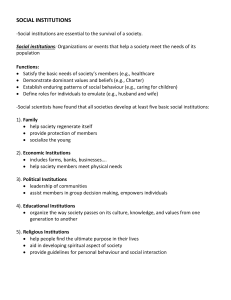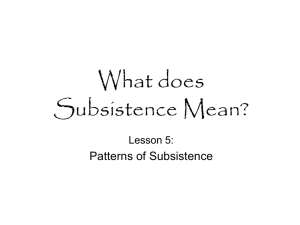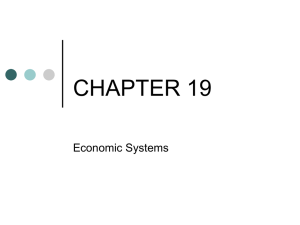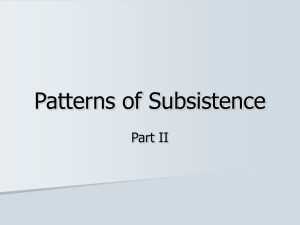Anth1000c Test 2 - Study Guide 1.
advertisement
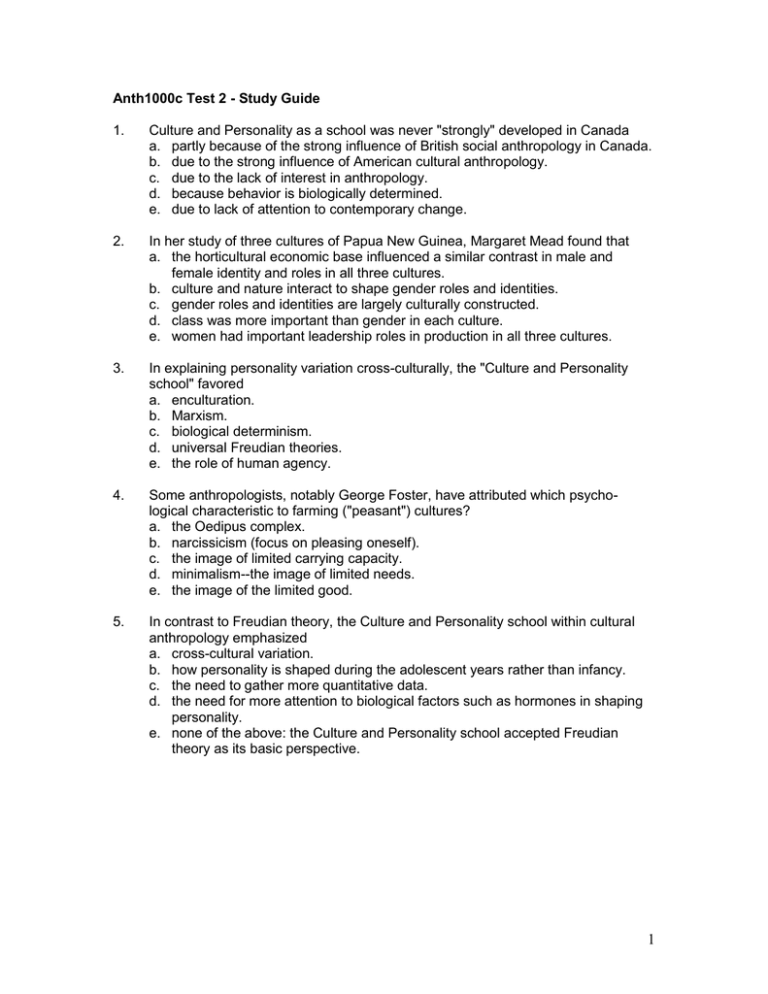
Anth1000c Test 2 - Study Guide 1. Culture and Personality as a school was never "strongly" developed in Canada a. partly because of the strong influence of British social anthropology in Canada. b. due to the strong influence of American cultural anthropology. c. due to the lack of interest in anthropology. d. because behavior is biologically determined. e. due to lack of attention to contemporary change. 2. In her study of three cultures of Papua New Guinea, Margaret Mead found that a. the horticultural economic base influenced a similar contrast in male and female identity and roles in all three cultures. b. culture and nature interact to shape gender roles and identities. c. gender roles and identities are largely culturally constructed. d. class was more important than gender in each culture. e. women had important leadership roles in production in all three cultures. 3. In explaining personality variation cross-culturally, the "Culture and Personality school" favored a. enculturation. b. Marxism. c. biological determinism. d. universal Freudian theories. e. the role of human agency. 4. Some anthropologists, notably George Foster, have attributed which psychological characteristic to farming ("peasant") cultures? a. the Oedipus complex. b. narcissicism (focus on pleasing oneself). c. the image of limited carrying capacity. d. minimalism--the image of limited needs. e. the image of the limited good. 5. In contrast to Freudian theory, the Culture and Personality school within cultural anthropology emphasized a. cross-cultural variation. b. how personality is shaped during the adolescent years rather than infancy. c. the need to gather more quantitative data. d. the need for more attention to biological factors such as hormones in shaping personality. e. none of the above: the Culture and Personality school accepted Freudian theory as its basic perspective. 1 6. Compared to children in horticultural societies, children in industrial societies are more likely to become socialized into which personality type? a. narcissistic. b. nurturant. c. paternal. d. maternal. e. none of the above: both societies equally promote an independentindividualistic personality type. 7. Children's personality formation is significantly affected by a. their mother's work patterns. b. the games they play. c. task assignments. d. formal learning. e. all of the above. 8. During World War II, Benedict and other anthropologists were commissioned to conduct national character studies based on "anthropology at a distance" to help understand their enemies. a. True b. False 9. Children who grow up in agricultural and industrial societies are more likely to have nurturant personalities than children who grow up in horticultural societies. a. True b. False 10. Solid evidence shows that gender patterns of aggressiveness and sociability are inborn. a. True b. False 11. The concept of "the child" as a special category emerged in Europe in only the last few centuries. a. True b. False 12. While puberty is a cross-culturally universal biological stage of life, adolescence is variously marked or unmarked. a. True b. False 13. Industrialized societies tend to emphasize and elongate the adolescent life phase. a. True b. False 2 14. In Canada, debates about surgical menopause and the safety of hormone replacement therapy confirm the medicalization of an event that is physiologically universal, but carries diverse cultural meanings. a. True b. False 15. Ruth Benedict's view of the Kwakwaka'wakw Indians of the Northwest Coast of Canada as having a "Dionysian" personality type of excess and revelry was based largely on their system of _______________. 16. "Nurturant-responsible" personalities are most likely to be formed in children living in societies in which the dominant mode of production is _______________. 17. Anthropologists use the term _______________ to refer to people in many Native American cultures who are genitally male but dress in female clothing and perform female tasks. 18. George Foster's theory of why small-scale farmers of Mexico do not seek actively to improve their economic condition is called the _______________. 19. Explain briefly why children in horticultural societies are more likely than children in industrial societies to grow up learning to be nurturant-responsible. 20. Define what is meant by a national character study. Mention an example of one such study. Describe what anthropologists now see as the major limitations of such endeavors. 21. Mongolian herders of the former Soviet Union are now adjusting to being part of a. a collectivized system. b. an agricultural way of life. c. the market economy. d. China. e. the urban poor. 22. Which mode of production has characterized most of human evolution? a. foraging. b. pastoralism. c. horticulture. d. agriculture. e. cannibalism. 3 23. Cultural revival among the Tiwi involves them in the market economy to a certain degree; before this, their economy was based mainly on a. foraging. b. pastoralism. c. horticulture. d. agriculture. e. a combination of pastoralism and horticulture. 24. An example of work that usually fits into the category of the informal sector is a. salesclerk in a department store. b. professional basketball player. c. college professor. d. sex worker. e. social worker. 25. The gender division of labor in the agricultural mode of production a. involves highly overlapping tasks for males and females in most societies. b. is more segregated than in temperate foraging societies. c. is generally the most egalitarian of all modes of production. d. tends to allocate both production and processing of food to men. e. means that men work more hours and women work fewer than in horticulture. 26. Compared to family farming, corporate farming is a. more geared to production for sale. b. more energy-efficient. c. less reliant on capital. d. declining in importance as an economic system in the United States. e. none of the above: there are no differences between the two. 27. Children have the most tasks in which economic system? a. intensive agriculture. b. industrialism. c. horticulture. d. pastoralism. e. none of the above: children's work roles are universally minimal. 28. Maintaining the fallow period is essential for the sustainability of which system? a. foraging. b. horticulture. c. pastoralism. d. agriculture. e. industrialism. 4 29. Property relations in most pre-agriculture economic systems are best termed a. communistic. b. feudal. c. use rights. d. class-based. e. all of the above. 30. The oldest mode of production is a. feudalism. b. colonialism. c. foraging. d. theft. e. gardening. 31. In foraging societies, the division of labor is a. organized within families. b. flexible. c. more gender-differentiated in polar environments than in temperate environments. d. differentiated by age. e. all of the above. 32. People living in Western industrial societies tend to have a philosophy about nature called a. mentalist. b. classist. c. sexist. d. dualist. e. racist. 33. The two most important factors on which the division of labor is based in horticultural societies are a. class and race. b. age and race. c. age and gender. d. gender and class. e. gender and race. 34. Compared to the foraging mode of production, in the industrial mode of production a. the number of hours people spend working per week is greater. b. the division of labor is more socially-egalitarian. c. the ability to satisfy needs is greater. d. social equality is greater. e. food production is achieved with less labor and less capital. 5 Page 6 35. The mode of production that is based on growing food on shifting plots of land is called agriculture. a. True b. False 36. According to the textbook, economic systems include three processes: production, consumption and sustainability. a. True b. False 37. Compared to horticulture, industrialism is a less sustainable system in terms of resources required for it. a. True b. False 38. If you work, earn wages, and have taxes taken out of your paycheck by the government, you are working in the _______________ sector. 39. The mode of production that depends mainly on herding animals and using their products is called _______________. 40. Name the five major modes of production. 41. How does the formal sector differ from the informal sector? 42. What are use rights? 43. How do foragers differ from family farmers in terms of the division of labor? 44. How do property relations differ in the various modes of production? Provide illustrations. 45. A "pure" gift is a. something that is given only once. b. the predominant form of exchange among foragers. c. something for which a "return" is not expected or calculated. d. the most common form of exchange in all modes of production. e. when reciprocity is immediate and completely balanced. 6 46. In 1884, Canadian government had banned potlatching and the winter ceremonials, however, potlatching a. is now completely unrecognizable from its pre-contact, traditional form. b. is completely extinct at present. c. still continued to be held furtively and openly among some groups, and are being revived by others. d. has become to resemble an American-style Christmas. e. no longer has any of the same functions, though people still exchange the same items. 47. Potlatches figure prominently in ethnographic descriptions of the northwest coast. According to the functionalist theoretical approach in explaining potlatch, a. food is best viewed as an adaptation to the local ecology. b. existence of potlatch provide a source of conflict for the people. c. grand display of surplus food is wasteful. d. potlatch networks provided a food safety net for the people in the region. e. potlatch was only restricted to entertainment and did not serve a function. 48. In foraging societies, the largest share of people's "budget" usually is devoted to a. parties, public ceremonies, festivals, etc. b. taxes, just like the rest of us. c. contributions and gifts for the chief. d. food and shelter. e. none of the above: foragers live in a "free" society. 49. The kula ring is an example of a. market exchange. b. the "pure" gift. c. hidden unbalanced exchange. d. balanced exchange. e. an elementary form of trade union. 50. Balanced exchange a. tends to involve social equals. b. best describes what happens at a shopping mall. c. involves only inexpensive, everyday items. d. is usually administered or regulated by a central leader or by the government. e. is non-existent in industrial societies. 51. Which of the following occurs as one moves toward the more industrialized end of the production continuum? a. increased balanced reciprocity. b. increased leisure time. c. increased reliance on eating meat. d. increased social equality. e. increased market exchange. 7 Page 8 52. The concept of entitlement failure has been used to explain a. the unequal distribution of deaths during famine. b. minimalist consumption among foragers. c. the high rate of income tax in industrial countries. d. the collapse of socialism in the former Soviet Union. e. the continued importance of guanxixue (favors and gift-giving) in China. 53. Weiner pointed out the importance of a. women's exchanges of food, bundles of banana leaves and woven skirts for mortuary ceremonies. b. men's kula ring exchange as a form of balanced exchange. c. market exchange may be based on the exchange of goods or money. d. pastoralism. e. industrialism. 54. If you were to spend time and money for your group's upcoming potlatch, you would be using your a. leisure-time fund. b. entertainment fund. c. ceremonial fund. d. special fund. e. recurrent costs fund. 55. In contrast to an entitlement bundle based on owning your own land and producing your own food, entitlements that involve exchange are referred to as a. indirect entitlements. b. exploitation. c. negative reciprocity. d. redistribution. e. the welfare state. 56. Among foragers, the largest budgetary category is devoted to a. basic needs. b. recurrent costs. c. ceremonial expenses. d. leisure. e. none of the above: foragers do not live in a "cash economy" and so the concept of a budget does not apply to them. 57. The profit motive most characterizes which economic system? a. foraging. b. horticulture. c. pastoralism. d. agriculture. e. industrialism. 8 58. Reciprocity is the mutual exchange of goods and services, or gifts and favours. a. True b. False 59. Consumption includes both what a person intakes (for example, food) and a person's expenditures used to support consumption. a. True b. False 60. Potlatching is currently illegal in Canada and the United States. a. True b. False 61. The basic needs fund is the largest budgetary category among foragers. a. True b. False 62. During a famine, a person is better off if they have access to indirect entitlements. a. True b. False 63. The Bengal famine of 1943-44 is an example of a politically-induced famine. a. True b. False 64. Money is the oldest form of item used for exchange. a. True b. False 65. The kula is an example of balanced reciprocity. a. True b. False 66. Anthropologists studying food systems try to consider both the material aspects of food practices and the communicative, symbolic meaning of food in order to explain food prohibitions and preferences. a. True b. False 67. A theory that seeks to explain a practice or belief in terms of how it contributes to the operation and maintenance of the culture involved is termed ___________. 9 68. Exchange within small groups of people who know each other, carried out in a personal and face-to-face situation, is characteristic of the form of exchange called ___________. 69. The budgetary fund that deals with the need for repair of tools, weapons, and shelter is referred to as the ___________ fund. 70. The theoretical perspective that views the Muslim taboo against eating meat from pigs in terms of the ecology and economy of the Middle East is called ___________. 71. What are the three most common modes of exchange? 72. Define entitlement. 73. Define the pure gift and give an example of what a pure gift might be. 74. What is redistribution as a form of exchange? 75. Provide an example of something non-tangible that people exchange. 76. Comment on how systems of production, consumption and exchange are linked. Provide examples from different kinds of economies. 77. Which lifestyle involves the least amount of work in procuring food? a. foraging b. horticulture c. agriculture d. industrialization 78. _________________ is the process of converting material resources to human use. a. Manufacturing b. Production c. Reproduction d. Agriculture 79. According to Karl Marx, political systems and ideology are based in economic processes. a. True b. False 80. Settling down to intensive agriculture is considered to be an example of progress in evolution because it provided a reliable food supply and increased the standard of living for human populations. a. True b. False 81. Foragers almost always work less hours per day than do agriculturalists. 10 a. True b. False 82. Prestige is a factor in economic systems a. only in societies that have a market system. b. only in agricultural societies. c. in all societies. d. only in societies that have redistribution. 83. All the following are true of pastoral societies EXCEPT a. they do not have task specialization by age and gender. b. they practice a seasonal type of nomadism called transhumance. c. access to migration routes and ownership of animals is typically organized around unilineal kin groups. d. their social organization is shaped by the type of animals they herd. 84. Horticulture a. is based on the use of the plow and irrigation. b. is practiced by forager societies. c. produces a food surplus sufficient to support stratification. d. allows the development of semi-permanent villages, but does not result in production of a food surplus sufficient to support stratification. 85. The subsistence pattern most likely to be associated with stratification is a. foraging b. pastoralism. c. horticulture. d. intensive agriculture. 86. Of the following, the best example of balanced reciprocity is a. distribution of meat among the !Kung. b. gift-giving within the American nuclear family. c. the Kula Ring among Trobriand Islanders. d. the New Guinea pig feast. 87. The kula ring of Trobriand Islanders is an example of a. generalized reciprocity. b. balanced reciprocity. c. redistribution. d. market exchange. 88. The Papua New Guinea pig feast is an example of a. generalized reciprocity. b. balanced reciprocity. c. redistribution. d. market exchange. 89. Of India's sacred cow, Marvin Harris argues that a. Hindus do not kill cows because they get more energy from the living cow's labor, milk, and dung than a dead cow would provide in meat protein. 11 b. sacred cow worship is superstition, which is prevalent in nonindustrial societies. c. people of India go hungry because they do not understand how to use the farm machinery which produces a food surplus in North America. d. Hindus do not need to kill cows for protein because they drink blood obtained while the cow is still living. 90. The economic system of balanced reciprocity a. is based on the exchange of goods of equal value. b. is based on the ability of one trader to take advantage of another. c. is commonly used to keep trading partners out of debt. d. is fairly disruptive of political alliances. 91. The economic system of generalized reciprocity a. is based on the exchange of goods of equal value. b. is based on the ability of one trader to take advantage of another. c. is commonly used to keep trading partners out of debt. d. is based on providing goods or services without expectation of an immediate return in kind. 92. Marvin Harris asserts that cultural practices a. are based on making the maximum use of available resources. b. are functional and must meet the needs of the society. c. are structural in relationship to the biological design of the brain. d. are based on making the maximum use of energy resources. 93. What generalization is often not true of intensive agriculture? a. food surplus b. egalitarian social structure c. plowing and irrigation d. fertilizer usage 94. ____________ is the central factor underlying systems of redistribution. a. Payment b. Debt c. Status d. Power 95. The Kwakiutl _________________ was aimed at extending the influence of a leader throughout a region by establishing networks of mutual indebtedness. a. potlatch b. giveaway c. pig feast d. none of the above 96. What explanation does Marvin Harris provide for the protection of cows in India? a. cows are sacred and thus outside of profane concerns b. cows are worth more alive than dead because they provide a myriad of economic benefits c. cows are not useful in Indian society because plowing was never implemented d. cows are the kharmic representation of the Brahma 12 97. Which economic practice leads to the greatest amount of personal property ownership? a. foraging b. pastoralism c. agriculture d. industrialization 98. Horticulture is a. the practice of subsistence gardening. b. a simple form of agriculture that produces little, if any surplus. c. a farming or gardening practice that does not use fertilizer. d. all of the above 99. Subsistence is the means whereby human groups convert environmental resources to their own use. a. True b. False 100. Industrialization increases the status of women by reducing the distance between the workplace and the home. a. True b. False 101. The postindustrial society based on a service economy reduces the gap between rich and poor because workers no longer have to commute to a workplace outside the home. a. True b. False 102. Generalized reciprocity is a form of economic exchange based on giving without expectation of a return in kind. a. True b. False 103. Cultural materialists believe that culture is based on the need to convert energy to human use. a. True b. False 104. Kinship systems and economic systems have virtually nothing to do with each other. a. True b. False 105. Of all human groups which is the most nearly equal in terms of sex roles? Why is this? 13 106. Comment on how systems of production, consumption and exchange are linked. Provide examples from different kinds of economies. 107 Explain briefly the relationship between mode of production and personality types. Give at least two examples. 108. Define what is meant by a national character study. Mention an example of one such study. Describe what anthropologists now see as the major limitations of such endeavors. 109 How do property relations differ in the various modes of production? Provide illustrations at least for two modes of production. 14

